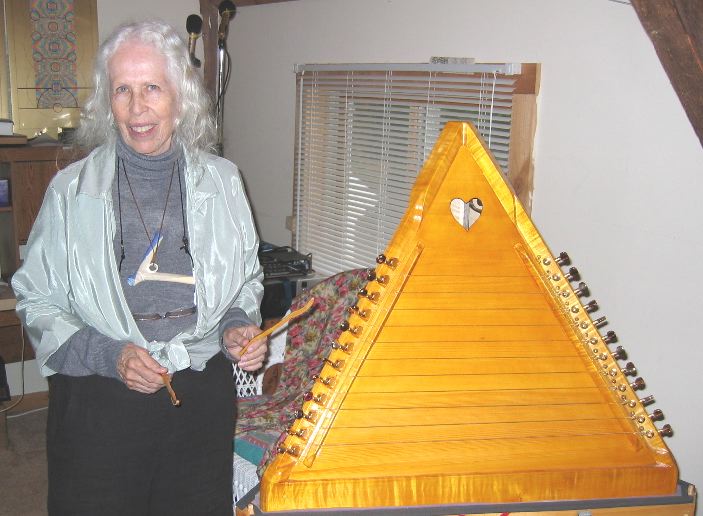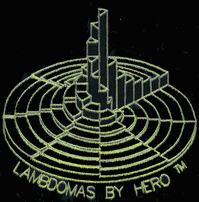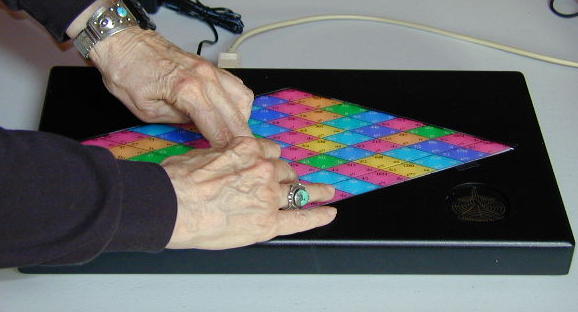Barbara Hero Discusses the Tetraharp
TRANSLATIONS ~ English to: 
Please read and agree to the copyright attribution requirements at the bottom of this page before utilizing any of this content amid your own. ヅ
"A Tetra-harp Therapy"
by Barbara Hero
reprinted with permission from
Harp Therapy Journal Spring 1999.
It is said that Pythagoras (500BC) played on a three-sided lyre. By strumming some well chosen chords he was able to transform negative emotions into calm and peaceful ones. A three sided construction would, by definition, be called a tetrahedron. For a harp of this construction three sides would be equilateral and each of the three sides would have strings tuned at proportional intervals so that a harmonic scale would result. There is little difference between the arts, music, mathematics and even architecture when one considers proportion as one of the factors. They all have their similar harmonic laws. These disciplines seem to be seeking to express a meaning within our place in the universe. These disciplines are helping in the evolution of the human race to a higher consciousness.
“ It is my hope that the therapeutic quality of these overtones may be explored and tested by harpists and other musicians.”
—Barbara Hero
The harmonic laws of the arts, music and mathematics meet in the electronic age. Harmonics involves proportion. Proportion involves whole number ratios. For instance, ratios from 1:16 through 1:1 to 16:1 applied to any phenomenon involves vibratory frequencies. The harmonic laws of music arc based upon fixed proportions of certain key signatures that are all structured to have their own mathematical laws based upon interval relationships of one note to another. Everything in our universe involves vibratory frequencies in different scales of pitches from high to low, and wavelengths in different scales of measurement from small to large. Therefore, the mathematics of music with its octaves representing higher an lower harmonics is a very useful tool for better understanding our physical world and the emotional, mental and spiritual nature of individuals in the human family.
The three sided Tetra-harp (tetrahedron) by its unique shape becomes a transmitting musical instrument, quite different from its four-sided pyramid cousin. A musical instrument of the Tetra-harp's design may help awaken awareness to the cosmic plan. Every acoustic instrument has body, resonance and its own character. One original idea was that it would be ideal for the Tetra-harp to find its own resonant harmonics, so that tuning would take place simply by the shape of the instrument.At each season when the lower strings move to a different pitch, the strings would be re-tuned to the frequency of the lowest pitch on the Dolphin side. The two other sides the Heart and the Third Eye are then tuned to the same fundamental frequency of the Dolphin side, from the 8th harmonic to the 19th harmonic.

The origin of the design began in the fall of 1994 when Dr. Marcia Epstein of the University of Calgary and I got together and brainstormed on an idea for constructing an acoustic musical instrument. As conceived by this design team, the harp would have moveable bridges and beads upon the strings. Richard Norley then made a schematic from our sketch for the design of a tetrahedron type harp with parallel horizontal strings. The idea simmered until the fall of 1995 when T. Gordon Anderson, a musician, singer, and instrument maker, became excited about the idea and fabricated the Tetra-harp. He constructed it by cutting three equilateral triangular sheets of spruce for the sounding board and using maple as the base. He designed one side to be tuned to a Lambdoma overtone series scale with twelve strings to be based upon a fundamental note of C at 32 cps (cyles per second), a frequency that falls between B and C on the lowest octave of a piano. On another side is a scale based upon the notes within the family of the fundamental frequency of C at l28 cps to F# at 7O4 cps. On the last side the longest bottom string is tuned to G at 96 cps to B at 480 cps. Each side necessarily has 12 strings of varying lenghts and weights, and separate movable bridges. He cut different shaped F-holes on each of the three sides to represent a dolphin, a third eye and a heart.
All wound strings are bright bronze (GHS brand).
The Lambdoma music system is also attributed to Pythagoras. The lambdoma tuning is done by carefully tuning the strings on each side to the frequencies within a whole-number-ratio matrix based upon a fundamental frequency of 256 cycles per second (slightly below middle C). The Dolphin side is tuned to the overtone series up to the 12th harmonic. This series becomes C(32), C(64), G(96), C(128), Eb(160), G(174), Bb(224), C(256), D(288), Eb(320), F#(352), G(348). The other two sides are then tuned from the eighth to the 19th harmonic. The Third Eye side becomes C(128), D(288), Eb(320), F#(352), G(348), Ab(416), Bb(448), B(480), C(512), D(576), Eb(640) and F#(704). The Heart side becomes G(96), Ab(208), Bb(224), B(240), C(256), D(288), Eb(320), F#(352), G(348), Ab(416), Bb(448) and B(480). The tuning can be quite arbitrary, but each side must be in harmonic relationship with the other two sides based upon the same fundamental keynote in different octaves.
With the Tetra-harp, most of the music played by musician friends are improvisations, in different tunings based upon the musical inspiration of the players. At workshops given in different parts of the country, the Tetra-harp is tuned to what seems to be the natural lowest fundamental pitch and all the other strings are tuned accordingly.
The people in the workshop take turns: the Tetra-harp is sometimes positioned over one person's head and shoulders, while three other persons play the three sides. The players are asked to pay loving attention to the person inside the Tetra-harp as well as paying attention to the music the other two people are playing. The person inside the harp often experiences a heightened level of consciousness. Some are extremely moved and the experience becomes part of an unforgettable positive shift of consciousness. Anyone may play the instrument with pleasure because the 36 strings demand no particular technique or even musical knowledge and there are not any predetermined rules to follow.
Left [below this paragraph in this reprint] are examples of scores using a Lambdoma harmonic tuning translated to a diatonic scale. The first one is in a modified key signature of C. Using the same interval patterning as before an overtone scale may be played based upon any chosen keynote. The intervals of the Lambdoma scale are quite similar to the musical scale of the harmonic minor. This similarity is of interest because the scores below reveal Lambdoma overtone scales in different keynotes from the first harmonic to the 16th harmonic. The keynotes may be identified by the first and last note in each scale. They were all adjusted to sharps for easier facility in playing. These scores are examples of translating some of the angles of the Meridians (pertaining to an acupressure system) into ratios. Then, by taking the arctangent of any Lambdoma ratio, one is able to identify the particular keynote that is derived form the Lambdoma matrix. (Figure 1)

It is my hope that the therapeutic quality of these overtones may be explored and tested by harpists and other musicians. ~ Barbara Hero
References
Lutz Berger: Musik, Malie & Medizin. Junfermann Verlag, Paderborn, 1997, pp.237-239.
Goldman J: Healing Sounds the Power of Harmonics. Element, Shaftesbury, Dorset Rockport, MA, 1992, pp.5,31,92.
Hero B: Some Effects of Whole Number Ratio Intervals in Music, Music in
Human Adaptation. Schneck DJ andJK, Virginia Tech, 1997, pp:107-132.
Hero B: Healing with Sound, Caduceus. "Sound Healing, healing into
wholeness," Issue 23, Warwickshire, England, 1994, pp:12-15.
Hero B: Lambdoma Unveiled (The Theory of Relatronshrps) Presentations,
Papers and Letters. Second Edition. Strawberry Hill Farm Studio Press.
496 Loop Road, Wells, Maine, 1992.
Barbara Hero is a visual artist, musician and mathematician. She is Founder/Director of the International Lamdoma Research Institute (ILRI) and Strawberry Hill Farm Studios. Her research of the ancient Egyptian Lambdoma musical/math tical matrix has led to the many paths of healing the emotional, spiritual, phys ical and mental bodies. She also presents one of her books with its 180 illustrations in color. This book indicates thebeginningof the resea rch she undertook after re-discovering the Lambdoma matrix.
Commemts from many viewers of the sites have led others to their own interpretations of what many call a "theory of all and everything."
IMPROVISATION MUSIC ON THE TETRA-HARP
(A description of the recording.)
Performed by Friends of Strawberry Hill Farm Studios
The inspiration for the Tetra-Harp was the under-standing that the ancient Greeks played a three sided lyre. The reason we named the harp "tetra" was because of its tetrahedron shape. Each side of the Tetra-Harp is an equilateral triangle with twelve strings of different weights. The Dolphin side is tuned to a Lambdoma overtone series. The lowest string on the Dolphin side represents the fundamental frequency. The string can be tuned to frequencies from F at 44 cycles per second (cps) to C at 64 cps, depending upon the desire of the player. The other two sides, the Third Eye and the Heart, are tuned an octave apart, with their lower strings in a higher octave range than that of the Dolphin side. The tuning can be quite arbitrary, but each side is in a harmonic relationship with the other two sides.
These pieces of music are improvisations, with different tunings, performed by musician friends at different times of the year. Because it is a rather unusual three-sided, acoustical, musical instrument (with 36 harmonically tuned strings), anyone may play the instrument with pleasure.
At workshops, people take turns: the Tetra-Harp is sometimes positioned over one person's head, while three other persons play the three sides. The players are asked to pay loving attention to the person inside the Tetra-Harp as well as paying attention to the music the other two people are playing. The person inside the harp often experiences a hightened level of consciousness.
The accoustic Tetra-Harp was a collaborative design by Barbara Hero, Founder-Director of the International Lambdoma Research Institute, Marcia Epstein, Professor of Interdisciplinary Studies at the University of Calgary and T. Gordon Anderson, musician and instrument maker. T. Gordon Anderson was commissioned to build the three sided tetrahedron-shaped musical instrument.
T. Gordon Anderson builder of the Tetraharp

